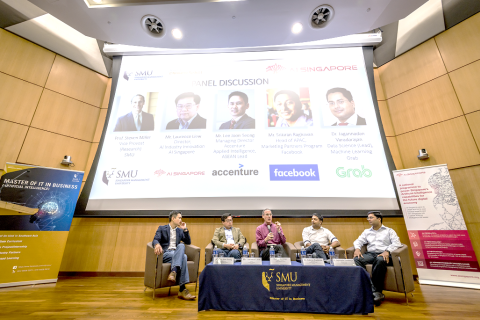
By Rebecca Tan
SMU Office of Research & Tech Transfer – So far, 2018 has been nothing short of an annus horribilis for social media giant Facebook. Since the publication of exposés detailing how user data was leaked to political consulting firm Cambridge Analytica, Facebook stock has taken a tumble, wiping out billions of founder Mark Zuckerberg’s wealth in the process.
Apart from the company’s handling of its users’ data, Facebook was also roundly criticised for the way it handled its public relations (PR). Not only did the company take four days to respond to the reports – an eternity in a news cycle accelerated, ironically, by social media – the eventual statement was also seen as not going far enough to address user concerns.
“For a start, I think they should have acknowledged that they already knew something had been breached three years ago; their statements came three years too late,” says crisis communication expert Augustine Pang, professor of corporate communication (practice) at the Singapore Management University (SMU) Lee Kong Chian School of Business.
Facebook’s fatal flaw, he continues, was not recognising the Cambridge Analytica crisis for what it was: a breach of trust that provoked a highly emotional response. Facebook, however, is not the first nor the only company to make this misjudgement. Most PR practitioners tend to operate on a rational approach to crisis communications rather than an emotion-based one, Professor Pang explains.
It’s (not) just emotion
In the rational approach, the assumption made by organisations is that stakeholders behave rationally and logically in times of crisis. “It assumes that people operate on a purely cognitive level, simply accepting or rejecting whatever an organisation says. In reality, emotions strongly influence the way the publics interpret statements made by organisations,” says Professor Pang.
“What my colleagues and I argue is that there are deep-seated emotions that need to be unearthed, and that once we understand the emotional responses to crises, organisations will be able to come up with better strategies to reach out to their stakeholders,” he explains.
Emotions, however, are complex, and different types of crises elicit different emotions. To find out which emotions are triggered by different types of crises, Professor Pang and his colleagues investigated the emotional responses recorded in 328 news reports of 14 different crisis types. These include reputational damage, transport failure, natural disasters and accidents, amongst others.
In the framework they built, called the integrated crisis mapping (ICM) model, crises fall into one of four quadrants depending on two factors: how involved the organisations are in managing the crisis (engagement), and how the stakeholders cope.
Let’s consider the stakeholder end. On one extreme, stakeholders can cope using what the researchers call a conative strategy, taking actions that change their relationship with the organisation. In the case of the Cambridge Analytica scandal for example, those who responded by deleting their Facebook accounts can be said to have taken a conative coping strategy. At the other extreme, stakeholders can adopt a cognitive approach, rationalising their own relationship with the organisation without actually changing it.
Caught up in anxiety, lost in anger
Interestingly, what Professor Pang and his colleagues found was that all types of crises triggered anxiety, regardless of which quadrant they fell into. In high-involvement, conative-coping crises, anxiety was found to be either the primary or secondary emotion experienced, followed by either anger or sadness. In low-involvement, cognitive-coping crises, anxiety was again the predominant emotion, followed by fright or anger. The researchers published their work in the Journal of Public Relations Research, a top journal in the field, in a 2012 article titled ‘Toward a Publics-Driven, Emotion-Based Conceptualization in Crisis Communication: Unearthing Dominant Emotions in Multi-Staged Testing of the Integrated Crisis Mapping (ICM) Model’.
What these results suggest, Professor Pang says, is that the first thing organisations should do in the event of a crisis is to send messages of assurance, directly addressing the anxiety experienced by their stakeholders. “If anxiety is the default emotion, what stakeholders need to know is that the organisation is doing everything it can to manage their situations,” he says.
The second implication is that organisations can facilitate the conative coping process by providing resources for stakeholders to take action, thereby preventing their frustration from spilling over into anger. For example, Professor Pang notes that while Facebook has provided some initial resources to help users reset their privacy settings, it has yet to come up with a comprehensive plan to explain to users what the company is doing with their data that had been breached.
“The lack of measures that people could take to protect their data could have driven them off the platform completely,” he says.
When theory reflects practice
Apart from developing new ways of understanding crisis communications, such as the ICM model, Professor Pang has been acknowledged as one of the forerunners in the development of the contingency theory of strategic conflict management, which is one of the leading theories in crisis communication.
Developed together with Professor Pang’s dissertation supervisor, Professor Glen Cameron of the University of Missouri, contingency theory is encapsulated in the statement ‘it depends’. ‘It’ refers to stance, which ‘depends’ on circumstances as evidenced in the influence of contingency factors. Stance is measured through a continuum, which has, at one end of the continuum, advocacy; and at the other end, accommodation.
“Regardless of what theories, models or concepts I work on, the goal is to reflect practice in theory so that theory can further inform and enhance practice. From contingency theory to the ICM model, the ultimate aim of all these theories is to give communication practitioners and business executives effective frameworks to build their practice upon. Theories must relate to and benefit practice,” says Professor Pang.
Back to Research@SMU Issue 55
See More News
Want to see more of SMU Research?
Sign up for Research@SMU e-newslettter to know more about our research and research-related events!
If you would like to remove yourself from all our mailing list, please visit https://eservices.smu.edu.sg/internet/DNC/Default.aspx

